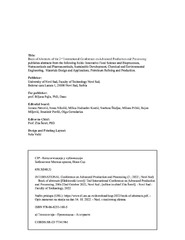Приказ основних података о документу
THE EFFECT OF PARTIAL PROTEOLYSIS ON TECHNO - FUNCTIONAL AND ANTIOXIDANT PROPERTIES OF MODIFIED SOY PROTEIN ISOLATES
| dc.creator | Klebec, Andrija | |
| dc.creator | Mamić, Marija | |
| dc.creator | Barać, Nevena | |
| dc.creator | Milinčić, Danijel | |
| dc.creator | Barać, Miroljub | |
| dc.date.accessioned | 2024-01-09T13:11:59Z | |
| dc.date.available | 2024-01-09T13:11:59Z | |
| dc.date.issued | 2022 | |
| dc.identifier.isbn | 978-86-6253-160-5 | |
| dc.identifier.uri | http://aspace.agrif.bg.ac.rs/handle/123456789/6728 | |
| dc.description.abstract | The partial enzymatic hydrolysis is effective and safe method which can be used to improve nutritive, techno-functional and functional properties of soy protein products. This method is affected by numerous factors. The objective of this work was to examine the effect of partial proteolysis on emulsifying and foaming properties of soy protein isolate. Also, the effect of proteolysis on ABTS-radical scavenging activity and iron (III) chelating ability was followed. Spray-dried soy protein isolate was prepared by isoelectric precipitation and modified using three different commercial proteases, Alcalase, Flavourzyme, and Papain. Initial isolate was hydrolyzed for 30, 60 and 90 minutes. Proteolysis was followed by the change of degree of hydrolysis (DH) and by native-PAGE, SDS-PAGE under reducing and non-reducing conditions. The effect of proteolysis on emulsifying properties was followed using emulsion stability index (ESI) and emulsion activity index (EAI). Also, foaming capacity and stability of foams formed using modified isolates were determined. Emulsifying and foaming properties was measured at pH 3, 5 and 7. Modified isolates were characterized with different DH values which were in the range of 11.75±0.08 (30 min, Papain) - 43.30±0.15 (Alcalase, 90 min). Limited proteolysis differently affected emulsifying properties of soy protein isolate. All modified isolates had improved emulsion stability at all investigated pH value whereas their ability to form emulsion was slightly lower or equal to initial isolate but in the range of commercial isolate used as standard. The highest stability had samples modified 30 min using Flavourzyme (366.94±48.85 min). Contrary, limited hydrolysis improved foaming capacity, but these foams were extremely unstable. The used enzymes differently affected the antioxidant properties of soy isolate. Only Alcalase improved radical scavenging activity of the initial isolate whereas the reducing power of all the investigated hydrolysates was lower than that of the initial isolate. Alcalase and Papain improved the ability of isolate to chelate iron (II) ions, whereas Flavourzyme-modified isolates had reduced iron (II) chelating ability. The initial IC50 of soy isolate was improved by 31.55-43.87% (Alcalase-modified) and by 21.08-60.40% (Papain-modified). | sr |
| dc.language.iso | en | sr |
| dc.relation | info:eu-repo/grantAgreement/MESTD/inst-2020/200116/RS// | sr |
| dc.rights | openAccess | sr |
| dc.rights.uri | https://creativecommons.org/licenses/by/4.0/ | |
| dc.source | 2nd International Conference on Advanced Production and Processing | sr |
| dc.subject | Soy protein isolate | sr |
| dc.subject | Limited proteolysis | sr |
| dc.subject | Emulsifying | sr |
| dc.subject | Foaming | sr |
| dc.subject | Antioxidant properties | sr |
| dc.title | THE EFFECT OF PARTIAL PROTEOLYSIS ON TECHNO - FUNCTIONAL AND ANTIOXIDANT PROPERTIES OF MODIFIED SOY PROTEIN ISOLATES | sr |
| dc.type | conferenceObject | sr |
| dc.rights.license | BY | sr |
| dc.citation.spage | 87 | |
| dc.identifier.fulltext | http://aspace.agrif.bg.ac.rs/bitstream/id/25596/19.pdf | |
| dc.identifier.fulltext | http://aspace.agrif.bg.ac.rs/bitstream/id/25597/20.pdf | |
| dc.identifier.rcub | https://hdl.handle.net/21.15107/rcub_agrospace_6728 | |
| dc.type.version | publishedVersion | sr |



